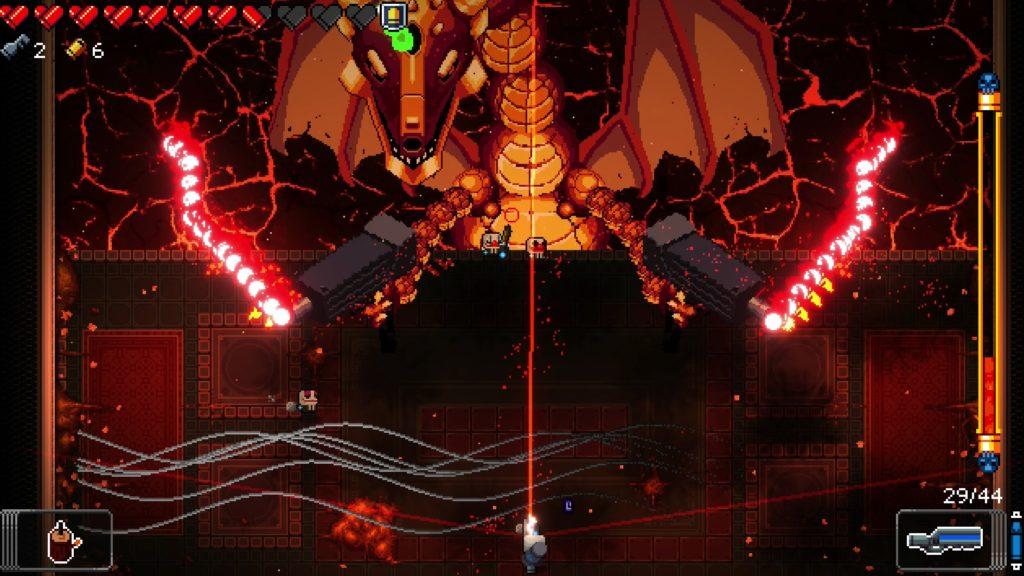Storyteller is a puzzle-based storytelling game by Annapurna Interactive, available on mobile and desktop devices. Given the game’s recurring themes of love and death, the game is rated for teens and up.
“How do the mechanics of the puzzle(s) influence the experience of the game?”
Mechanics: Each chapter is defined by a narrative theme that dictates the grounds for success in that chapter. Additionally, the player is given a specific set of scenes, characters, and a certain amount of panels to build their narrative around. This set of tools and instructions act as control mechanisms and direct the player’s actions.
- Character behaviors: When you place a character in a panel, their behavior helps clue player’s in on the logic of their story-in-progress. For example, if Edar marries Bernard and Isobel marries Lenora, putting Edgar in Isobel’s death frame wouldn’t make sense since Edgar has no connection to Isobel. The game nudges the players in the right direction by having Edgar look confused when placed in Isobel’s death panel.
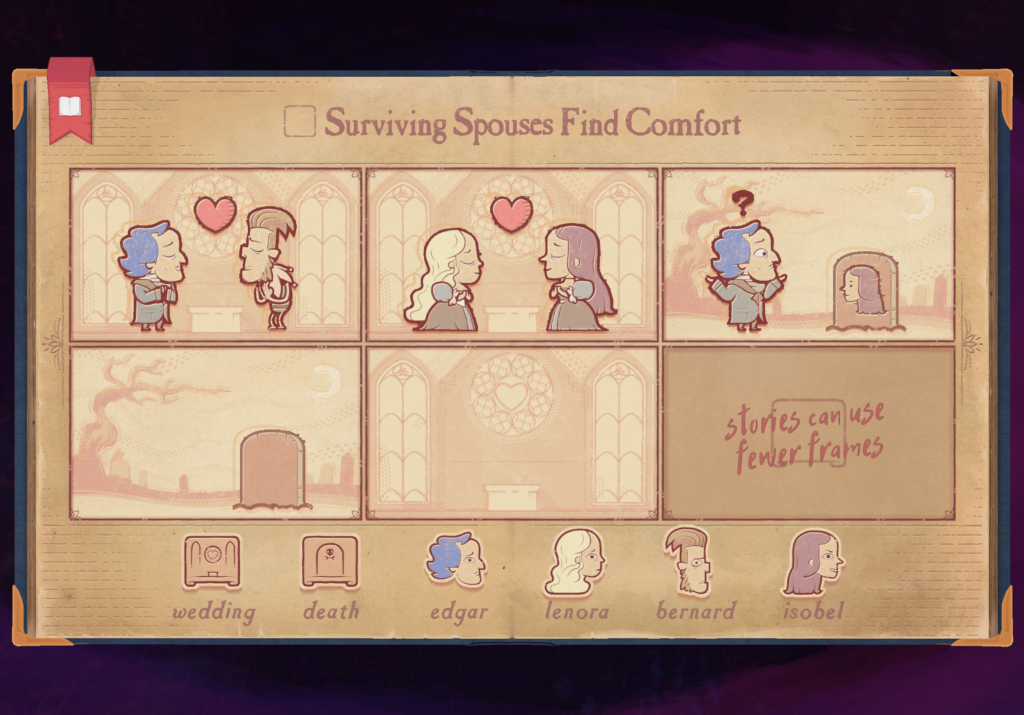
[IMAGE: Surviving Spouses find Comfort]
- Speech bubbles and emojis: The game helps manage the player’s active memory by utilizing character speech bubbles and symbols to remind players of pre-existing relationships they’ve created. The most prime example of this is in the chapter “Everyone Rejects Edgar,” where each panel contains some visual reminder of the relationship between the two characters. Hearts symbolize love between characters, speech bubbles containing another character with a heart symbolizes that their heart belongs to another, a broken heart represents heartbreak from rejection or loss. This helps manage the player’s story by giving the player a visual shortcut to remembering character dynamics so that they could easily manipulate and swap panels to solve the chapter.
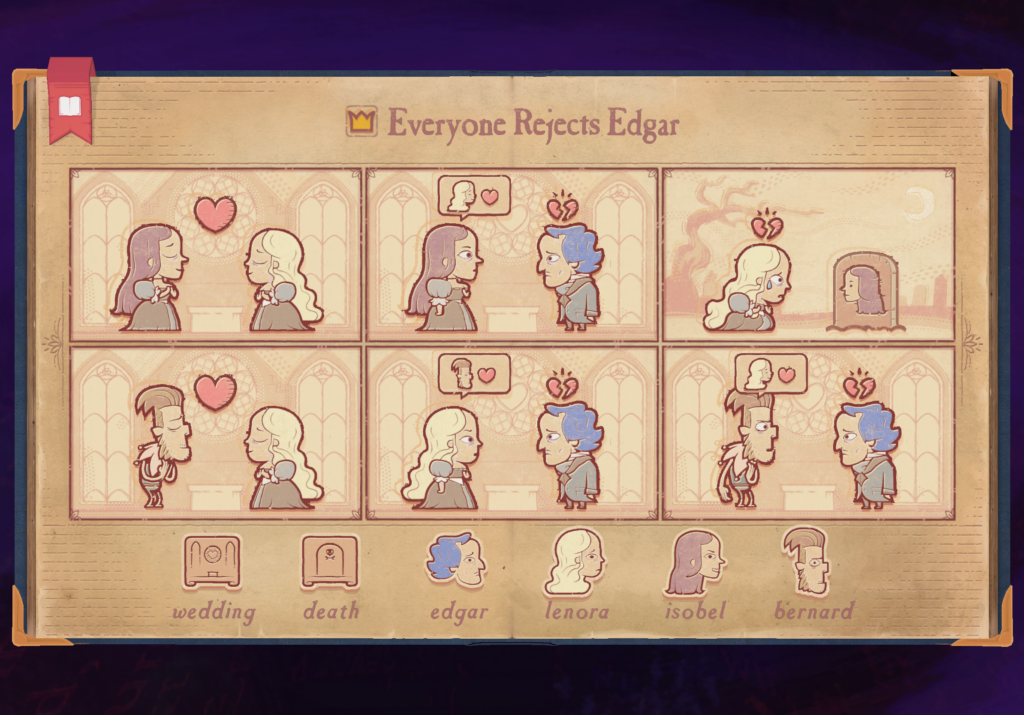
[IMAGE: Everyone Rejects Edgar]
- Open-ended story formula with tools: As long as the story fulfills the minimum requirements set by the chapter, the player is left to create as many alternative stories within the constraints of the chapter. For example, in “Heartbroken Spouses are Reunited”, the bare minimum requirements of the chapter are that 1. Two characters need to be in love, 2. The love interests must both experience heartbreak, and 3. The love interests must be reunited at the end. Given the narrative tools that the player is given, namely, the wedding/death/revive scenes and the Edgar/Lenora characters, the player is given the tools to infer that Edgar and Lenora are the love interests and that their heartbreak should be related to death and reunification as a result of revival. At first glance, these tools and creative constraints may seem like too tight of a constraint for player creativity, but any sequence of story is accepted as long as the requirements are met, leaving room for multiple interpretations for how the characters and tools should be used. For example, Edgar and Lenola can both pass away and be revived to reunite in the land of the living, or they can both pass away and reunite in the afterlife.
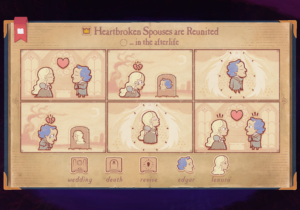
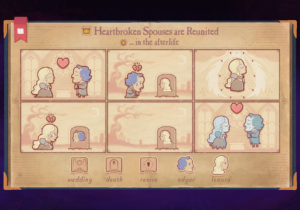
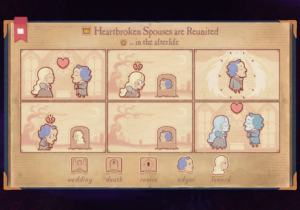
[IMAGES: Heartbroken Spouses are Reunited 1-3]
Aesthetics: Expression, narrative, and challenge.
- Expression: Playing around with different sequences of scenes and characters becomes a way for players to express themselves, even though their experiments may not be the solution to the chapter.
- Narrative: The player engages in the act of creating their own narratives according to that chapter’s theme.
- Challenge: With creative limitations such as the amount of story panels, availability of scenes and characters, and the chapter’s theme, each chapter comes with its own obstacles to create a new chapter narrative.
Dynamics: Comics as an aesthetic experience. Each chapter’s story is broken down into motion panels. These panels create an aesthetically pleasing experience of animated comic panels that the player can frame their narrative in.
Ethics
While each story consists of only a couple of panels, the game emphasizes plot-driven narratives with clear cause-and-effect relationships and clear resolutions. This narrative structure lends itself to Western styles of storytelling, such as the hero’s journey archetype. This narrative storytelling style, along with each chapter’s themes on individual characters finding love or going through tragedy, assumes that players have knowledge on Western storytelling culture. This may exclude players who are more familiar with Eastern styles of storytelling, which prefer cyclical structures, non-linear storylines, and sometimes ambiguous endings. The constraints of the game and their definition of a “story” may push away players who want to exercise their puzzle storytelling skills but with alternative perspectives. To remedy this, I suggest adding extra scenes such as flashbacks and cycles to add more narrative variety on top of the linear stories available to the players.



